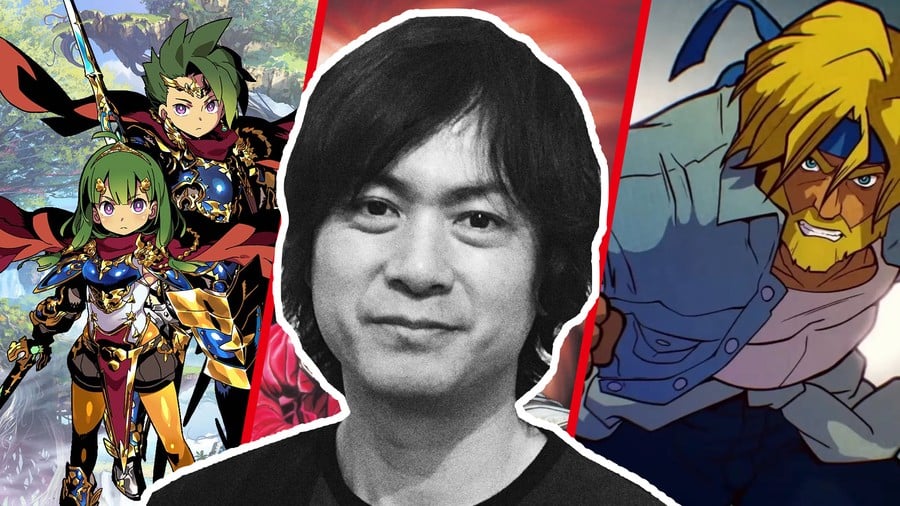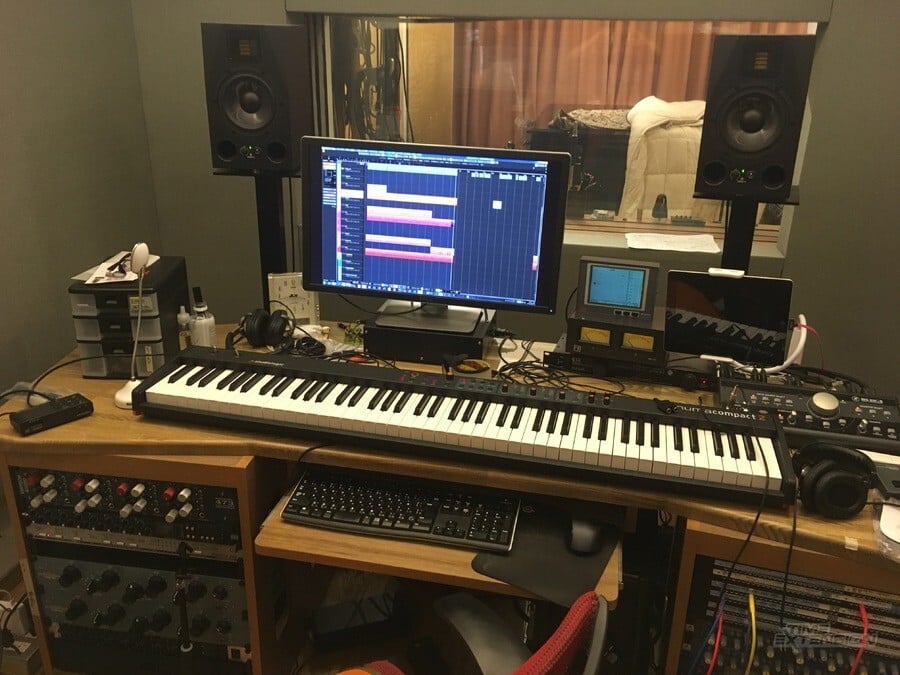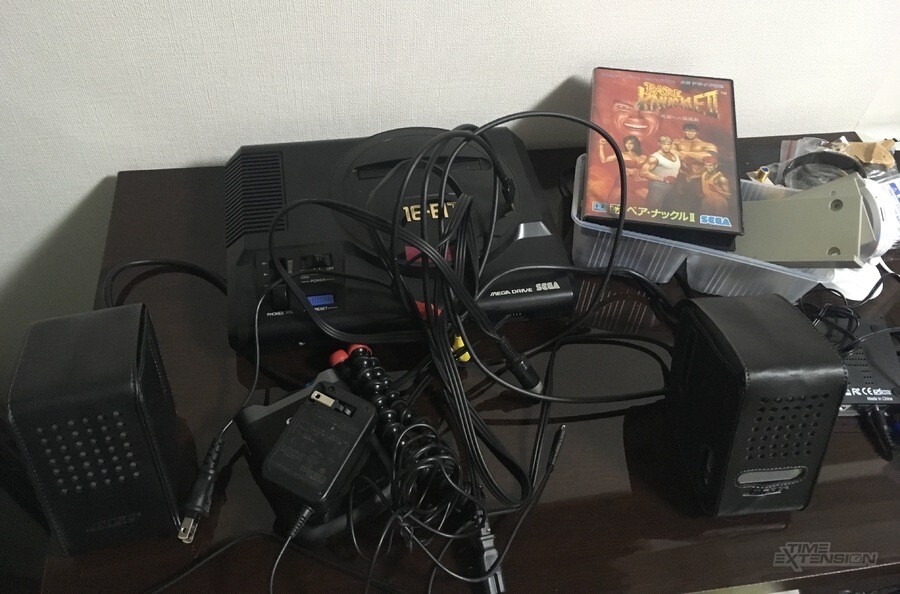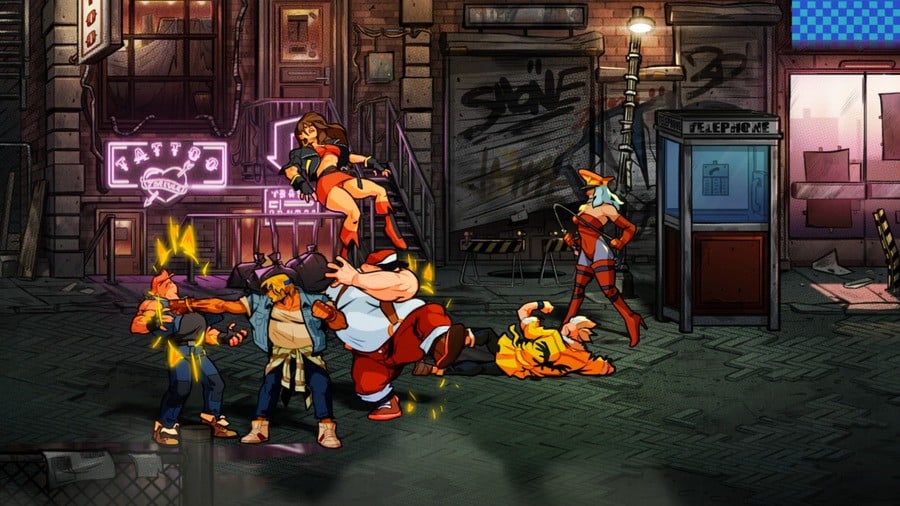
As one of the video game world's first musical superstars, Yuzo Koshiro needs no introduction. He took the relatively humble audio hardware of the Sega Mega Drive and made it do things no one thought were possible; his soundtracks for the likes of Revenge of Shinobi and Streets of Rage are lauded as classics to this very day.
However, Koshiro-san's career has been so much more than just music for key Sega games; he has a strong portfolio on Nintendo systems thanks to the two ActRaiser games and the Etrian Odyssey series. He also runs Ancient, a studio he founded with his mother and sister in the early '90s.
Fresh from the news that he would be contributing to the soundtrack of Streets of Rage 4, we were lucky enough to be invited into Koshiro-san's Tokyo studio for a chat about his career; past, present and future.
Nintendo Life: We understand that your mother taught you the piano from the age of 3. Was this where your interest in music started? What made you want to be a musician?
Yuzo Koshiro: My mother was a piano teacher and she was very strict, she often scolded me or slapped my hand if I played the piano not so good. I didn’t like her teaching, I had always wanted to run away from practising the piano. Playing classical music on the piano was so boring for me as a child. However, I came to like playing the piano and synthesisers since I became a fan of Yellow Magic Orchestra [YMO] when I was 13, and at the time my mother bought me a Korg Delta synthesiser which has analogue synthesis and polyphonic strings as well. I really loved playing YMO music like Rydeen, Technopolis, etc. with my Korg Delta. I’m not sure if I would call this being a musician, but I started creating music as a music composer and I started to work at Nihon Falcom.
Who were your main musical influences growing up? Are there any people or groups outside of electronic music who you really loved? Musicians or bands etc.
After YMO, I loved classical music. And any kinds of music! I can’t choose only one person, but regarding classical music, I loved Brahms and Gustav Mahler. I love him. My father was a big vinyl geek, he had more than 1000 records! Lots of vinyl! So he played every genre of vinyl for days on end while I was sleeping. At first, I was bothered when he played contemporary music which was hard to understand for me, but I got used to it and loved it eventually. Therefore I came to love any kind of music!

Were you aware of any other video game composers at the time? Were there any who you admired?
There were a lot of people! But particularly Koichi Sugiyama’s work.
You first started working on video game music at Nihon Falcom using a PC-8801. What was it about video game music specifically that appealed to you? At the time, the hardware must have been extremely limiting.
Since the days before Space Invaders came out, I loved arcade games. I loved the amusement arcades since I was a kid. In those days, the arcade games were made using discrete circuits, and the sound systems of the time were also made using discrete circuits rather than a sound chip such as PSG. I really loved that kind of primitive sound which was very similar to the vintage analogue synthesiser. So since then, game sound was very special to me. As you said, sound chips had very limited abilities, but for me, that was not a problem because I was really into the game sound itself.
What did you think of the sound capabilities of the PC-8801 compared with other hardware of the time such as the Famicom, PC Engine, etc.?
Well, I loved FM synthesis so that’s why the PC-88, in particular, is very special to me.
The important thing is how easy it is to create music without any stress. That is the reason why I used the PC-88 series to create Mega Drive music
Even after moving on to producing music on the Mega Drive for Sega, you still used the PC-88 to produce all your music. What was it that made the PC-88 so special for you? Was it difficult to make your music sound the same on the Mega Drive?
Back in the day, to make Mega Drive games you needed to buy or rent a development kit from Sega first, and you also needed a very expensive PC, such as an NEC PC-98 series machine for programming, and Sharp X68000 for creating graphics. On top of that, you had to make a contract with Sega as a development company. As such, the development community was very restricted. That was very difficult for personal reasons. But if you want to create just music, using a PC-88 was the best choice. Later models of PC-88 have an FM sound chip close to the one that the Mega Drive has, so you could create Mega Drive music using just a PC-88.
Also, since the PC-88 series was very popular, selling more than 900,000 units at the time, there was a big community and we could get lots of technical information. Therefore, I could make MUCOM88, which was a music programming tool, working on the PC-88 SR with my friend’s help and by reading the technical source. MUCOM88 is very easy to use and you can access any part of the YM2608 sound chip. Also, I could update MUCOM88 at any time because I made it myself so I had been updating the tool for the latest music styles. I know that the sound is a bit different between the PC-88 and Mega Drive, but that’s not a big deal. The important thing is how easy it is to create music without any stress. That is the reason why I used the PC-88 series to create Mega Drive music.
The Mega Drive itself was well known for producing a sharp FM synthesis sound well suited to the kind of gritter games that the Mega Drive became famous for. Was this a good match for your own personal style of music?
I didn’t know if it was a match for my music style at first because I started to compose with my PC-88, many of the arcade games at the time used FM sound chips and I really loved them. Therefore it was natural that I loved the Mega Drive which has the same sound chip on-board.
So would you say that it was just lucky that it had a matching FM sound chip?
Yes! Very lucky!
How would you say the sound hardware of the Mega Drive differs from that of the Super Famicom?
Well, the Mega Drive has an FM sound chip while the Super Famicom has an SPC700, which is a polyphonic PCM sound chip and very different. To make Super Famicom music, you needed to rent very expensive Unix-based hardware from Sony. This was around 10,000,000 yen. So, very expensive!
In the west, the Streets of Rage soundtrack is probably your most well-known work. The Mega Drive was a huge success in the west, and Streets of Rage was one of the more popular franchises on the platform. Is the response different in Japan where the Mega Drive struggled against the Super Famicom and PC Engine?
I know that the Streets of Rage series was popular in the West, but in Japan is was very different, as you said. The Mega Drive had fallen behind the Super Famicom in terms of sales. People wanted to play Nintendo games, as well as RPGs such as Dragon Quest and Final Fantasy which were not released for the Mega Drive. I think, on the other hand, the Mega Drive fans loved the arcade games. More than that, the club music which I had created for Streets of Rage was not so popular at the time in Japan. It was after the late '90s that club music flourished in Japan. In those days, people who loved game music preferred rock and jazz because most of the popular games had those music styles.
The club music which I had created for Streets of Rage was not so popular at the time in Japan
We’ve actually seen a growth of interest in Sega machines among retro gamers in Japan despite Sega machines not being so popular in the region and nostalgia presumably being quite low. Why do you think this is?
I think it is because people get a lot of information from the internet about retro games, I think that is the reason that people have come to love them.
What do you think about the fact that more people in Japan are now aware of your work?
I am very happy about that!
Streets of Rage 4 was recently announced, and the first question on everybody’s lips was whether you were involved in the project. Indeed, it is difficult to imagine Streets of Rage without your music. How did you get involved in that? Were you involved from the start, or was it a response to fan requests?
I wasn’t involved from the start. I found they had already started the project when I got an email from DotEmu. In that email, some screenshots were attached. There was the title screen logo and some characters and background graphics, they had already started the project at that time. Actually, after they revealed the project, I saw a lot of messages from fans on Twitter say they wanted me to join the project. I met the DotEmu staff for the first time at Diggin’ in the Carts Live, which was held in Paris on September 2018. They came to my hotel and showed me a very early demo of Streets of Rage 4 on a laptop PC. I played the game right away, it was so amazing! The graphics are great! The most interesting thing is the feeling of the actions, it is very close to Streets of Rage 2 which is the most popular title of the series. It was more than perfect as it also has additional actions as well. However, I hadn’t decided to join the project at the time. I met them again at BitSummit in Kyoto in June 2019. There was a first meeting where all the Japanese composers who would join the project got together. They brought the latest version of Streets of Rage 4 to BitSummit. I played the game again at the DotEmu booth and it looked way better than the previous version that I played in Paris, and thought it was great. I admired the game, so after that, I decided to join the project.

I think everybody is glad that you joined the project! Moving to the Super Famicom, with ActRaiser you used a completely different type of music to what we had previously heard from you, less electronic and more focused on an orchestra. How was that for you?
The music was actually my first orchestra-style composition. The reason why I wrote that kind of style was because the Super Famicom has a polyphonic sampling sound system which Nintendo adopted with their console, and that is very suitable for realising orchestra sound which was impossible on the FM sound chips. That was a big difference from the previous work. And as I said before, I love any kind of music style so orchestra music was one of the genres that I have been wanting to create since I started my work as a musician.
I suppose you would have had to buy the expensive music development kit for that!
Ah, I actually rented it!
You also worked on a lot of other games for Nintendo systems such as Etrian Odyssey, what was it like to make music for that hardware given that you really like FM synthesis and this was very different?
I think the reason why Sega came to me and asked me to create the music is they chose 4 titles which I was involved with as the composer in the line-up of the Mega Drive Mini
Actually, it was not so different in terms of making music. In recent years, there haven’t really been any real big changes to the sound system used in consoles since the PlayStation, which also uses a polyphonic sound chip. But until the late '90s, the development applications for music were really troublesome to use because they were less compatible, very slow and sometimes crashed! More than that, they were also very expensive! If you bought the full set using a Macintosh system, it cost over $10,000 USD! But since 2000, we can use almost all of the music applications on either the Macintosh or Microsoft Windows at a lower price, and they are very fast and stable. There are very few errors, and less stressful to use, feeling similar to when I used the PC-88.
You’re also producing the menu music for the upcoming Mega Drive Mini. Do you still work with Sega, or is this just a one-off? Did Sega come to you specifically?
I haven’t been working on any specific titles with Sega recently, this is just a one-off. I think the reason why Sega came to me and asked me to create the music is, firstly, they chose 4 titles which I was involved with as the composer in the line-up of the Mega Drive Mini; and secondly, because the staff involved in the project are perhaps fond of my work!
Have you used the Mega Drive Mini yourself?
I have! It feels great! It has the same feeling and control as the old Mega Drive. It is very good!
Are you happy that your games are on there? What do you feel about that?
I am very happy! I want young people to be able to play my games!
Even today, you have a close relationship with your fans and regularly do live performances as far away as the UK. What does it feel like to know that your music is so important to people across the world all these years later?
I am very happy to see that the fans are still coming to the live concerts which we did last year around the world! I want people to come to my show to enjoy the setlist made especially for the live show that people wouldn’t be able to experience in the games.

Is it hard to adapt to game music to a live situation? You have looping music in games, after all.
Yeah, it is very difficult because game music is played by a sequencer which is harder to play by hand, and I needed to play some melody when doing the live show, so that was difficult. With the issue of looping music, I needed to prepare many tracks and connect them as one piece of music so that there are no loops. That is a big difference.
Aside from music, you also moved into the business of actually making video games by forming Ancient with your mother and sister. Was it difficult to shift from being a freelance music producer to actually having to be involved in the running of a business? What roles did you play in Ancient beyond music?
Working as a company president while doing my job at the same time is very hard work
It is very difficult because we are a very small company so I always have a lot of jobs to do such as looking over every contract, discussing with our staff and other people outside of the company and so on; I have a lot of jobs! That is really tough work. You have to concentrate hard on creating music if you want to be a good musician, but on the other hand, I have to keep an eye on the state of my company, how our staff works, etc. Working as a company president while doing my job at the same time is very hard work, but it’s just one of those things! I do my best!
You made the original Sonic the Hedgehog for the Master System, too; what was it like to adapt the Mega Drive game to the Master System? The Master System wasn’t so popular in the US and Japan, but for us Europeans, it was bigger than the NES and the Master System version was very popular. Some even prefer the pace over the Mega Drive game. What kind of challenges did you face?
Sonic for the Master System was my company’s first game, so it was very difficult! In terms of sound, the Mega Drive uses an FM sound chip while the Master System uses PSG, so it is very different. I needed to create original music for the Master System, that was a challenge. In terms of the game, the Mega Drive is obviously better than the Mark-III [Master System] so our programmer had difficulties making the scenes similar to the Mega Drive. It was not good if they both looked so different. It was very difficult to port to the Master System.
Did you ever consider using the FM capabilities of the later Japanese Master System and addon for Mark-III?
Not really, because very few people had the additional sound capabilities. I don’t think it was a very good idea.
Most people in the west associate you with Sega, but you in fact worked entirely on a freelance basis after leaving Nihon Falcom (aside from the formation of Ancient). What other projects did you really enjoy working on?
Contrary to the old and unique consoles until 3DS, Switch has a relatively new and common architecture, like a PC
Recently, Wangan Midnight and Etrian Odyssey, because Wangan Midnight has very up-to-date electronic music like trance, EDM, etc. I really love creating dance music ever since I composed Streets of Rage back in the day. On the other hand, Etrian Odyssey mainly uses rock-style music played using live instruments. Since I grew up with band music using live instruments, I love the music style and genre as well.
You've previously expressed caution about supporting the Switch at Ancient. Has that changed?
Now Ancient is developing a sequel to Gotta Protectors for Switch. We are planning to release the JP version by the end of this year and the English version by the next spring. I think that Switch as a gaming platform is very attractive for small game development companies like us. Contrary to the old and unique consoles until 3DS, Switch has a relatively new and common architecture, like a PC. They also offer the development kit at an affordable price. It seems like Nintendo recently gives more importance to Indie games.
And finally, what are your plans for the future? Do you still have the same passion for video game music, or are there any other challenges that you feel like undertaking?
Of course, I have even more passion for video game music compared with the past! I always keep challenging myself the expand the possibilities of game music, and I want to try to create music for other music such as movies and anime in the future as well.
We'd like to thank Yuzo Koshiro for giving up his time to speak to us. You can follow him on Twitter.
This article was originally published by nintendolife.com on Sat 24th August, 2019.






Comments 14
The only Yuzo Koshiro song i listened and played on DDR was this song.
From one of your questions: "You have to looping music in games, after all."
I'm guessing this was a typo.
Anyway, I love YK's music. Streets of Rage 2 and the various Etrian Odyssey games have some of my all time favorite video game soundtracks. His work has a classic, very gamey quality to it, like he's bringing the musical identity of the Genesis into a modern context.
Koshiro is an absolute legend and of course he’s a fan of Yellow Magic Orchestra! I believe Sega licensed Rydeen in one of their early games.
I love it when Nintendo Life do these articles! It is interesting to see what developers think of the switch(other than EA because they dislike the switch as they can't monetise it). Please keep doing these!
Nice article! I love his work for Etrian Odyssey series.
Good of you to bring up his previous less-than-positive comment on Switch. I remembered the previous interview and was wondering if his stance had changed since then as I went through
I love Yuzo Koshiro, it makes so much sense that he’s a fan of Yellow Magic Orchestra. I’d love to see him make a list in the style of Itoi, it was nice to see him actually confirm the influences Randy Newman and Harry Nilsson had on the Mother soundtrack.
Ohhh I didn’t realize it was him that did the trance music for Wangan Midnight Maximum Tune games. It’s one of the few times I’ve liked modern game music enough to download a few tracks.
Stream of Tears - https://youtu.be/TFJq4hB3Swc
Cause You’re Different - https://youtu.be/4hDBMDWdvXw
Thankyou Koshiro absolute legend x
I love the music in Etrian Odyssey. Wish it was available on some music service.
Edit: omg the soundtrack of EO Nexus is on Apple Music, sweet.
@StableInvadeel @Prizm Can confirm that both EO Nexus and Wangan Midnight Maximum Tune 5 & 6 soundtracks are on Spotify too.
A true diamond in the rough. Actraiser, Ys Book I & II, and Streets of Rage are some of my favorite game soundtracks.
Never commented on a NL article before but I'd like to share a YK story. Several years ago I was searching for a CD of ActRaiser Symphonic Suite (you should look that up if you don't know what that is) but it was out of print. Somehow I stumbled onto Ancient's website so I left an inquiry. Mr Koshiro sent me a personal email thanking me for my interest in his music and offered to send me a ripped copy of the CD (for free) and he did just that along with a copy of the CD sleeve artwork at that. I was floored. That's what kind of person he is.
I thought he had it once the new smash bros came..
Show Comments
Leave A Comment
Hold on there, you need to login to post a comment...